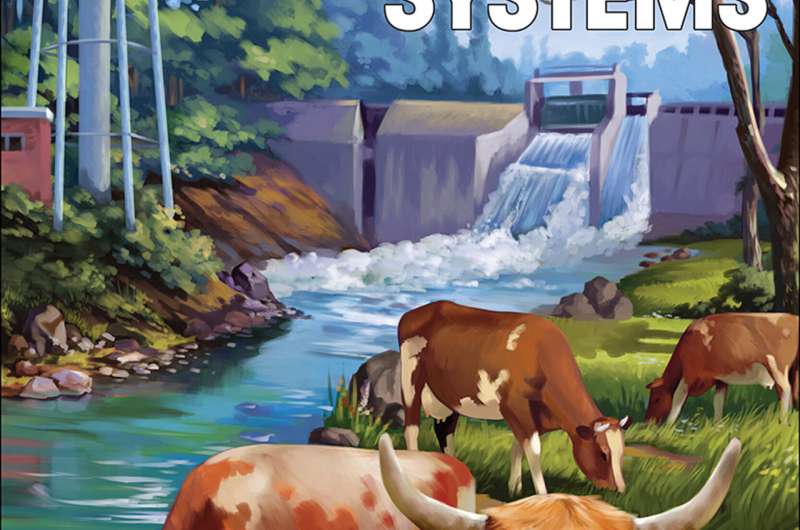Waste milk could be used to reduce power plant carbon dioxide emissions

Clarkson University research, which shows how surplus milk may be used to capture carbon dioxide (CO2) from fossil‐fuel based power plant emissions, is featured on the front cover of the November issue of Advanced Sustainable Systems.
The stylized cover artwork features a North Country landmark, the surge tank of a Raquette River hydroelectric plant in nearby Hannawa Falls, where two of the paper's authors resides.
Two major sources of greenhouse gasses are CO2 emissions from fossil-based power plants and methane emissions from cattle. There is a strong scientific consensus that emissions like these are causing human-induced climate change.
The article, "CO2 Capture: Dry and Wet CO2 Capture from Milk‐Derived Microporous Carbons with Tuned Hydrophobicity," explains that it is possible to greatly reduce power plant CO2 emissions by using surplus or waste milk from cows to create activated carbons, which will adsorb or scrub the CO2 from the output.
"Our challenge was to create an inexpensive 'green' activated carbon," says co-author Associate Professor of Chemistry & Biomolecular Science and Kodak CAMP Distinguished Professor Mario Wriedt. "Powdered milk can be converted into advanced activated carbons with the right porosity and surface chemistry to adsorb the CO2, allowing much better control than with the current materials used for this process, like coconut shells or coal."
This is the first report of state-of-the-art performance for an activated carbon derived from a natural compound. The process for making the sorbents is similar to what is done to roast coffee, but with a secondary agent that etches nanoscale holes onto the material.
"Think of extremely dark roast holey coffee beans," says co-author University of Texas at Austin and former Clarkson Professor David Mitlin. "The nanoscale holes, because of their strict sizes and surface chemistry, are very effective in trapping CO2 while keeping out water vapor. The CO2 is trapped reversibly in the carbon sorbent's micropores, which can be reused once the CO2 is released from its pores."
Wriedt notes that the dairy product used in the process would not be taken from the food supply.
He says that although milk consumption has declined more than 30 percent since 1980, there has been a 13 percent increase in annual milk production per-dairy-cow, creating an oversupply in which farmers now dispose of more than 50 million gallons of milk annually. "This use of waste milk could actually be a boost for the dairy industry," he says.
The article says that cows on average release from 150 to 260 pounds of methane per year and that employing their milk to capture CO2 would also help to offset this emission.
The researchers say that these milk-derived carbon sorbents could also be used in other applications as well, like indoor air purification or water treatment, and that commercialization of the process may be in the future.
The paper's other co-authors are former Clarkson graduate students Jesse Pokrzywinski, Darpandeep Aulakh, and Hubert Bilan; Clarkson chemical engineering undergraduate student Sam Marble; and Mitlin's postdoctoral researcher Viet Hung Pham.
The research was enabled by a Clarkson University Craig-Ignite Research Fellowship.
Advanced Sustainable Systems is an international, peer-reviewed, interdisciplinary journal publishing outstanding research results on the development and implementation of systems, solutions, technologies and applications that share the focus on the advancement of sustainable living.
More information: Jesse Pokrzywinski et al. Dry and Wet CO 2 Capture from Milk‐Derived Microporous Carbons with Tuned Hydrophobicity, Advanced Sustainable Systems (2020). DOI: 10.1002/adsu.202000001
Provided by Clarkson University




















